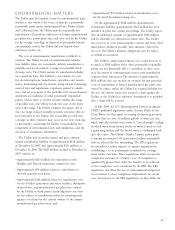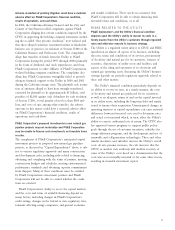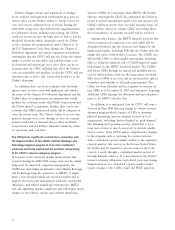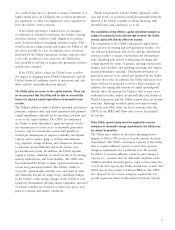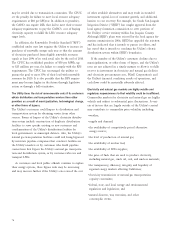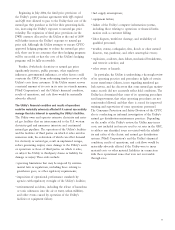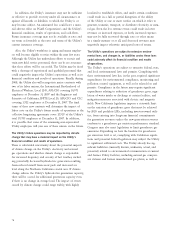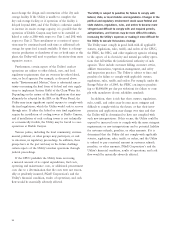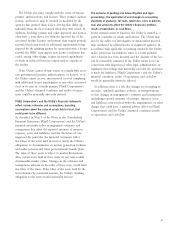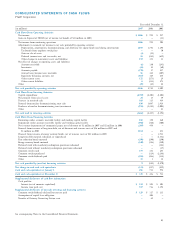PG&E 2007 Annual Report Download - page 77
Download and view the complete annual report
Please find page 77 of the 2007 PG&E annual report below. You can navigate through the pages in the report by either clicking on the pages listed below, or by using the keyword search tool below to find specific information within the annual report.75
also could decline due to a general economic downturn or if
higher energy prices in California due to stricter greenhouse
gas regulations or other state regulations cause customers to
leave the Utility’s service territory.
If the Utility experiences a material loss of customers
or reduction of demand by customers, the Utility’s existing
electricity purchase contracts could obligate it to purchase
more electricity than its remaining customers require. This
would result in a long position and require the Utility to sell
the excess, possibly at a loss. In addition, excess electricity
generated by the Utility’s generation facilities may also have
to be sold, possibly at a loss, and costs the Utility may
have incurred to develop or acquire new generation resources
may become stranded.
If the CPUC fails to adjust the Utility’s rates to refl ect
the impact of changing loads, PG&E Corporation’s and the
Utility’s fi nancial condition, results of operations, and cash
fl ows could be materially adversely affected.
The Utility relies on access to the capital markets. There can
be no assurance that the Utility will be able to successfully
fi nance its planned capital expenditures on favorable terms
or rates.
The Utility’s ability to make scheduled principal and interest
payments, refi nance debt, and fund operations and planned
capital expenditures depends on its operating cash fl ow and
access to the capital markets. The CPUC has authorized
the Utility to make substantial capital investments in elec-
tric transmission to secure access to renewable generation
resources and to accommodate system load growth, in
natural gas transmission to improve reliability and expand
capacity and to replace aging or obsolete infrastructure
(e.g., pipelines, storage facilities, and compressor stations)
to maintain system reliability, and in the electric and
gas distribution system. In addition, the Utility expends
capital to replace, refurbish, or extend the life of its existing
nuclear, hydroelectric, and fossil facilities. The CPUC also
has authorized the Utility to make capital investments in
several new generation facilities. The Utility’s ability to
access the capital markets and the costs and terms of avail-
able fi nancing depend on many factors, including changes
in the Utility’s credit ratings, changes in the federal or state
regulatory environment affecting energy companies, increased
or natural volatility in electricity or natural gas prices, and
general economic and market conditions.
PG&E Corporation’s and the Utility’s fi nancial condi-
tion and results of operations would be materially adversely
affected if the Utility is unable to obtain fi nancing with
favorable terms and conditions, or at all.
The completion of the Utility’s capital investment projects is
subject to substantial risks and the rate at which the Utility
invests capital will directly affect net income.
The completion of the Utility’s anticipated capital invest-
ment projects in existing and new generation facilities, elec-
tric and gas transmission, and electric and gas distribution
systems is subject to many construction and development
risks, including risks related to fi nancing, obtaining and
complying with the terms of permits, meeting construction
budgets and schedules, and satisfying operating and environ-
mental performance standards. Third-party developers of
generation projects to be owned and operated by the Utility
also face these risks. In addition, the Utility may incur costs
that it will not be permitted to recover from customers. In
addition, the timing and amount of capital spending will
directly affect the amount the Utility is able to earn on its
authorized rate base, which in turn will affect the ability of
PG&E Corporation and the Utility to grow their net income
over time. Although recorded capital costs may be trued
up in the next GRC, there can be no assurance that the
CPUC or the FERC will allow such costs to be included
in rate base.
If the Utility cannot timely meet the applicable resource
adequacy or renewable energy requirements, the Utility may
be subject to penalties.
The Utility must achieve an electricity planning reserve
margin of 15% to 17% in excess of peak capacity electricity
requirements. The CPUC can impose a penalty if the Utility
fails to acquire suffi cient capacity to meet these resource
adequacy requirements for a particular year. The penalty
for failure to procure suffi cient system resource adequacy
capacity (i.e., resources that are deliverable anywhere in the
CAISO-controlled electricity grid) is equal to three times the
cost of the new capacity the Utility should have secured. The
CPUC has set this penalty at $120 per kW-year. The CPUC
also adopted “local” resource adequacy requirements for
specifi c regions in which locally-situated electricity capacity






